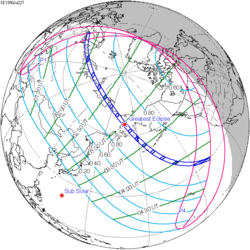| Hybrid eclipse | |
| Gamma | 0.9931 |
|---|---|
| Magnitude | 1 |
| Maximum eclipse | |
| Duration | 0 s (0 min 0 s) |
| Coordinates | 59°54′N37°06′W / 59.9°N 37.1°W |
| Max. width of band | 1 km (0.62 mi) |
| Times (UTC) | |
| Greatest eclipse | 19:06:15 |
| References | |
| Saros | 124 (53 of 73) |
| Catalog # (SE5000) | 9479 |
A total solar eclipse occurred at the Moon's descending node of orbit on Friday, October 3, 1986, [1] with a magnitude of 1. It was a hybrid event, with only a fraction of its path as total, and longer sections at the start and end as an annular eclipse. A solar eclipse occurs when the Moon passes between Earth and the Sun, thereby totally or partly obscuring the image of the Sun for a viewer on Earth. A total solar eclipse occurs when the Moon's apparent diameter is larger than the Sun's, blocking all direct sunlight, turning day into darkness. Totality occurs in a narrow path across Earth's surface, with the partial solar eclipse visible over a surrounding region thousands of kilometres wide. The Moon's apparent diameter was near the average diameter because it occurred 8.3 days after apogee (on September 25, 1986, at 11:00 UTC) and 3.7 days before perigee (on October 7, 1986, at 10:50 UTC). [2]
Contents
- Observations
- Eclipse details
- Eclipse season
- Related eclipses
- Eclipses in 1986
- Metonic
- Tzolkinex
- Half-Saros
- Tritos
- Solar Saros 124
- Inex
- Triad
- Solar eclipses of 1986–1989
- Saros 124
- Metonic series
- Tritos series
- Inex series
- References
- External links
Totality occurred for a very short time (calculated at 0.08 seconds) in an area in the Atlantic Ocean, just east of the southern tip of Greenland. The path, on the surface of the Earth, was a narrow, tapered, horse-shoe, and visible only from a thin strip between Iceland and Greenland. A partial eclipse was visible for parts of North America, Central America, the Caribbean, northern South America, and Iceland. This eclipse was the last central eclipse of Solar Saros 124 and the only hybrid eclipse of that cycle.



































































































